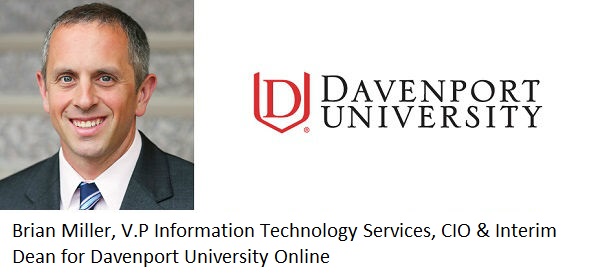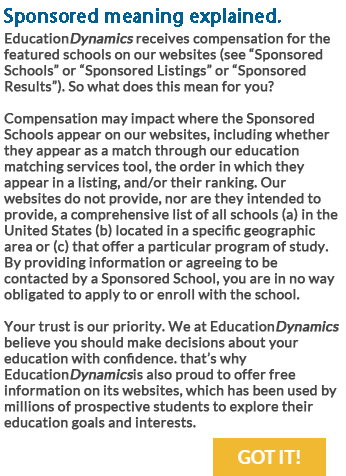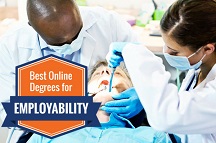It’s easy, it’s lonely, it’s a scam; anyone who works in online education has heard all this nonsense before. Online degrees may be growing in popularity, but that doesn’t mean there aren’t plenty of misconceptions still surrounding these programs.
Here are seven of the most common misconceptions that prospective students and the public tend to have, along with some info on the truth of the matter to bust these myths once and for all.
1. Only in it for the money
Myth: “Schools that offer online degrees are all for-profit diploma mills.”
Fact: This one is so far from the truth that it’s amazing there are people who still believe it. National institutions have been getting into the online education game with regularity over the last several years, and their online programs rank among the best:
| University Name | Online Program Ranking | Traditional Program Ranking |
| Penn State University | 3 | 8 |
| University of Florida | 5 | 14 |
| University of Alabama | 7 | 36 |
| University of Illinois | 9 (tie) | 11 (tie) |
| University of Wisconsin | 9 (tie) | 11 (tie) |
| Source: Top Online Bachelor’s Programs & Top Public Universities, U.S. News and World Report, 2014 | ||
Not only can students get a good education from online degree programs, in some cases there are only a handful of on-campus programs that can deliver a better one.
2. The easy way out
Myth: “Online degree programs are an easy way for students to get degrees without working hard.”
Fact: Sure, it’s true that online programs can make it easier for students to fit their education into a busy work or family schedule. But the notion that scheduling flexibility translates to a whole curriculum of blow-off classes is a total misconception.
Dr. Jessica McSheck Houston has been teaching online courses for over a decade. “Online learning platforms offer a wide range of flexibility,” she said in an interview, “however, the course work is as rigorous as an educational program at a brick-and-mortar school. Students who commit to learning online quickly realize that they must be extremely disciplined and determined.”
3. Bad for business
Myth: “Employers don’t respect applicants who earned their degrees online.”
Fact: According to a 2010 study conducted by opinion pollsters Zogby International, a full 83 percent of executives believed that there was no difference between an online degree and one earned in a traditional campus setting.
In fact, the name of the school that granted the degree held much more weight in employers’ eyes than the method by which it was earned. Online degrees and on-campus degrees from the same familiar institution carry essentially the same weight.
4. Together but alone
Myth: “You never interact with other students in online courses.”
Fact: According to Dr. Patrick Jones, vice provost of Excelsior College, students in some online classes may interact more with one another than their brick-and-mortar counterparts.
“Virtually all online courses require students to engage with each other through weekly discussion questions, peer review of student work and other forms of collaboration,” Dr. Jones said in an email interview. “In contrast, most traditional courses (especially those general education courses with faculty to student ratios in the 1:200 range) have no such requirement.”
5. Resource-free
Myth: “Online students don’t have access to the same resources as traditional students.”
Fact: It may have been the case a decade ago that online educational resources lagged behind, but the gap is closing fast. Virtual libraries, online learning labs, degree advisement, job placement assistance and alumni services are available at online schools across the country.
Certain institutions do offer different resources than others, though, so students are encouraged to check with an advisor or registrar to ensure that their chosen school has what they need.
6. Disconnected professors
Myth: “Online professors don’t engage with students like they do in on-campus programs.”
Fact: Many online programs work to ensure that faculty-student communication is abundant and effective. Professors tend to respond to discussion board posts, emails and curriculum questions within a day or so, and most online class software makes it fairly simple for students to reach out.
Professor engagement can even be inconsistent in fully campus-based programs. Professor-student interaction tends to be more a function of the individual professor than the method of class delivery.
7. MOOC hype
Myth: “Online classes are all MOOCs, and MOOCs don’t work.”
Fact: To address the second part of the myth first, MOOCs can be great for a certain type of student — they just take a particular learning approach. Also, despite their relentless 2012-13 hype machine, very few classes in online degree programs are actually massive open courses.
Dr. Diane M. Gayeski, dean of the Roy H. Park School of Communications at Ithaca College, sets the record straight: “The most successful courses are not MOOCs, they are SPOCs (small, private online courses) in which an intentionally small group of students work very closely and collaboratively with each other and with professors.”
Get experienced
There are many more misconceptions out there, these are just a few of the most common. Anyone with preconceived notions about online education should research a little deeper — the truth might be surprising.
Sources:
Best Online Bachelor’s Programs, U.S. News & World Report, 2014, http://www.usnews.com/bachelor/education/online-education/bachelors/rankings
Top Public Schools, National Universities, U.S. News & World Report, 2014, http://colleges.usnews.rankingsandreviews.com/best-colleges/rankings/national-universities/top-public/spp+50
“Employers on online education,” CNN Living, Rachel Zupek, March 29, 2010, http://www.cnn.com/2010/LIVING/worklife/03/29/cb.employers.online.education/index/
Interview, Dr. Jessica McSheck Houston, June 26, 2014
Interview, Dr. Patrick Jones, June 26, 2014
Interview, Dr. Diane M. Gayeski, June 26, 2014





















 Brian Harfe, Associate Dean of the College of Liberal Arts and Sciences, & Jennifer K. Smith, Director of Development and Course Production for UF Online at the University of Florida
Brian Harfe, Associate Dean of the College of Liberal Arts and Sciences, & Jennifer K. Smith, Director of Development and Course Production for UF Online at the University of Florida Renata Engel, Associate Vice Provost for Online Programs, & Karen Pollack, Assistant Vice Provost for Undergraduate Online and Blended Programs at Penn State University
Renata Engel, Associate Vice Provost for Online Programs, & Karen Pollack, Assistant Vice Provost for Undergraduate Online and Blended Programs at Penn State University

